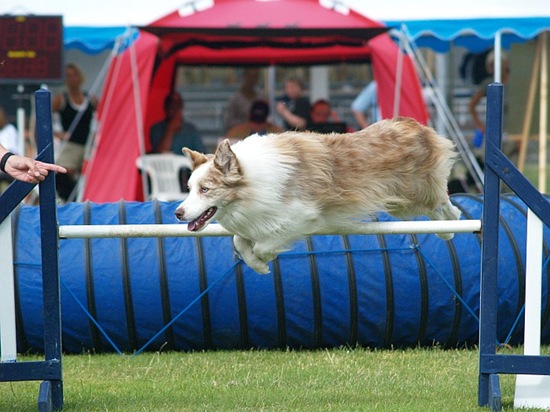When To Add Heights To Jumps
Last Saturday I drove to Horsens to give the first of two lectures on jumping skills. Many of the dogs participating was only one year of age and very new to jumping. This brought up the subject of when to increase jump height with young dogs.
Agility competitors are focused on jump heights, and it seams like they want the bar to be at competition height as soon as possible. But the height of the jump is really the last thing to be worried about.
When jumping the dog has to focus on 6 components:
- Path
- Distance
- Take-off spot
- Weight transfer
- Angle of elevation
- Jump height
This means the dog has to multitask, and the last thing it has to focus on is the height of the jump. When height becomes the main issue for agility handlers they forget to take the time to teach the 5 other components. If your dog masters all the other components then height won't be a problem.
There are many things to consider when deciding if it's time to add height to a jump with a young dog. The obvious is, of course, to make sure your dog is healthy and not overweight.
I never introduce height to dogs younger than one year of age. For large breeds I might even wait a little longer. It's a good idea to wait until the dog is fully grown and the growth plates are closed. If a dog jumps that aren't physically ready you might course small fractures in bones that aren't completely calcified yet.
I introduced Zap and Bob to a jump bar for the first time last week (they'd turned a year this week). They have both been working on puppy grids with speed bumps since they were four months of age.
I kept moving the jump bar for every repetition so they had to pay attention to it. They got 5 repetitions each and the maximum height of the jump was 25 cm. It might not seem like much at all, but they really had to think to work out the challenge.
As a rule of thumb you should never let dogs under 15 months jump higher than the height of their elbow. Some might not agree with me on this one but then again I'm not the one aiming to get my dogs ready for competitions as soon as possible. I rather do it right than rush through the most important part of our training; foundation.
Building a solid foundation is just one of experiences I have gained from training 8 dogs. It is so much easier to do it right from the beginning than having to fix problems later on.
After a few successful jump grids repetitions with height, I add height to sequencing. I never introduce handling and jump height at the same time! Introducing handling and height at the same time would be working on two criteria at the time and this should not be your preferred way to train your dogs. The progress would be too slow and the whole process might not be very positive because the dog would have to concentrate on how to jump while trying to interpreting your handling. You might accidently teach an incorrect respond to your handling.
Through flatwork I make sure my dog has a clear understanding of how to respond to my handling; front and rear crosses, acceleration/deceleration etc. Flatwork is also part of my warm up routine and this means we revisit flatwork often. To me and my dogs it's a game like playing tug or Frisbee.
With Jazz, Zap and Bob I've worked through Susan Garrett's one jump exercises using a jump with a speed bump. This way you build a lot of value for the jump plus you get to practice handling without height.
When flatwork and one jump exercises have been introduced properly it's time to add some height when sequencing. What I think is very important at this point is to interpret how your dog is responding when the challenge is increased. Does he hesitate before the jump or does it look easy to him? Does he put in extra strides or is he refusing and running around the jump? All of this is something to be aware of and to act on - you might have rushed your training and are pushing your dog too fare.
In conclusion be aware of your dog and decide what you are working on at each session; if you are working on heights and jumping skills then don't start out combining it with difficult handling. Increase the jump height incrementally but don't push it. Variation is the key so don't set all bars at the same height. Most important of all make sure your dog knows how to jump before you start spicing it up with handling. Remember to set the dog up for success - a confident dog is a fast dog.
Jumping skills is one of those things you just can't rush. It takes time to build a solid foundation, but I grantee you won't regret it.

